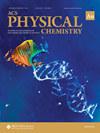跃迁态共振从根本上改变了62 ~ 102 meV能量范围内F + H2→FH(vf = 3) + H反应的角分布
IF 4.3
Q2 CHEMISTRY, PHYSICAL
ACS Physical Chemistry Au
Pub Date : 2025-02-04
DOI:10.1021/acsphyschemau.4c0009610.1021/acsphyschemau.4c00096
引用次数: 0
摘要
基准反应F + H2(vi = 0)→FH(vf = 3) + H的反应角分布表现出不同寻常的小散射角倾向,这是文献中长期争论的主题。我们使用Regge轨迹来量化共振对状态到状态微分截面的贡献。向复杂能量极点的转换使我们能够将这种效应几乎完全归因于过渡态共振,这种共振长期以来一直存在于F + H2系统及其同位素变体F + HD中。为了详细分析角散射,我们使用了DCS_Regge包,它是最近为此目的而开发的[Akhmatskaya, E.;索科洛夫斯基博士。理论物理。[j].生物工程学报,1997,26(2):387 - 387。本文章由计算机程序翻译,如有差异,请以英文原文为准。
A Transition State Resonance Radically Reshapes Angular Distributions of the F + H2 → FH(vf = 3) + H Reaction in the 62–102 meV Energy Range
Reactive angular distributions of the benchmark F + H2(vi = 0) → FH(vf = 3) + H reaction show unusual propensity toward small scattering angles, a subject of a long debate in the literature. We use Regge trajectories to quantify the resonance contributions to state-to-state differential cross sections. Conversion to complex energy poles allows us to attribute the effect almost exclusively to a transition state resonance, long known to exist in the F + H2 system and its isotopic variant F + HD. For our detailed analysis of angular scattering we employ the package DCS_Regge, recently developed for the purpose [
求助全文
通过发布文献求助,成功后即可免费获取论文全文。
去求助
来源期刊
CiteScore
3.70
自引率
0.00%
发文量
0
期刊介绍:
ACS Physical Chemistry Au is an open access journal which publishes original fundamental and applied research on all aspects of physical chemistry. The journal publishes new and original experimental computational and theoretical research of interest to physical chemists biophysical chemists chemical physicists physicists material scientists and engineers. An essential criterion for acceptance is that the manuscript provides new physical insight or develops new tools and methods of general interest. Some major topical areas include:Molecules Clusters and Aerosols; Biophysics Biomaterials Liquids and Soft Matter; Energy Materials and Catalysis

 求助内容:
求助内容: 应助结果提醒方式:
应助结果提醒方式:


